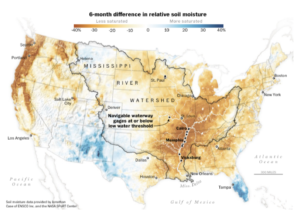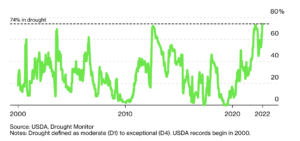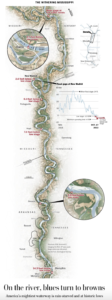“In its outlook for the coming winter, National Oceanic and Atmospheric Administration scientists said they expect drought conditions to worsen in the lower Mississippi Valley, with the climate pattern known as La Niña expected to bring dry conditions to the southern tier of the United States.”

Today’s article added that, “The Army Corps regularly dredges the river bottom to maintain a channel that is at least nine feet deep, enough to float towboats and the barges they push. The riverbanks are also dotted with structures that extend from the banks toward the center of the river, designed to send water flowing toward the channel and create currents that help maintain its depth.
“The Corps has had five vessels out on the river in recent weeks to conduct emergency dredging, needed when barges get stuck and the channel becomes impassable, [Lisa Parker, a spokeswoman for the Mississippi Valley Division of the Army Corps of Engineers] said. Each time, the river channel is closed for at least 12 to 24 hours, further disrupting already slow barge traffic. Tuesday’s brief rain helped increase river flows throughout the lower Mississippi basin, Parker said.”
Dow Jones writer Kirk Maltais reported yesterday that, “Rates for barges carrying grains on the Mississippi River have turned back higher, this after easing back from record highs. For the week of October 25, the St. Louis barge spot rate rose nearly 22% from last week to $88.46 per ton – below a record of $105.85 per ton reached earlier this month but still very high. ‘Because of low water levels on the Mississippi River System, barge companies have little capacity in the spot market as they struggle to meet current commitments,’ said the USDA in its latest Grains Transportation Report.”
Approximately 74% of winter #wheat production is within an area experiencing #drought. pic.twitter.com/tvGBQwpzH2
— FarmPolicy (@FarmPolicy) October 27, 2022
Also yesterday, Bloomberg writers Kim Chipman and Dominic Carey reported that, “Drought is rapidly expanding across America’s crop belt, making it so dry that in some fields fertilizer is evaporating from the soil and plants are struggling to emerge from the ground.
“Almost three-quarters of the US’s winter wheat growing area is in moderate to intense drought, according to the latest government data. That’s a record high based on records going back to 2000. Dryness this time of year not only stunts the growth of winter wheat, but can hamper fertilizer applications on fields for crops to be planted in the spring — both of which could reduce crop yields and push prices higher.”

“Farmers are busy finishing up planting winter wheat — a variety that typically comes up from the ground before going dormant during the coldest months and then resuming growth as temperatures warm. But lack of moisture could hinder or even prevent some plants from emerging until spring, putting yields at significant risk,” the Bloomberg article said.
Meanwhile, Reuters News reported yesterday that, “Russia on Thursday said that provisions of the Black Sea grain deal to ease Russian agricultural and fertiliser exports were not being met, and that Moscow was yet to make a decision on whether the agreement should be extended.”
And Reuters writers Humeyra Pamuk and Steve Holland reported yesterday that, “The United States strongly supports the efforts of United Nations to ensure the Black Sea grain deal is renewed, White House spokesperson John Kirby said on Thursday, saying that would help bring food prices down.
“Speaking to reporters in a call, Kirby said any talk by Russia on disrupting the deal was ‘essentially another method of weaponizing a commodity.'”






